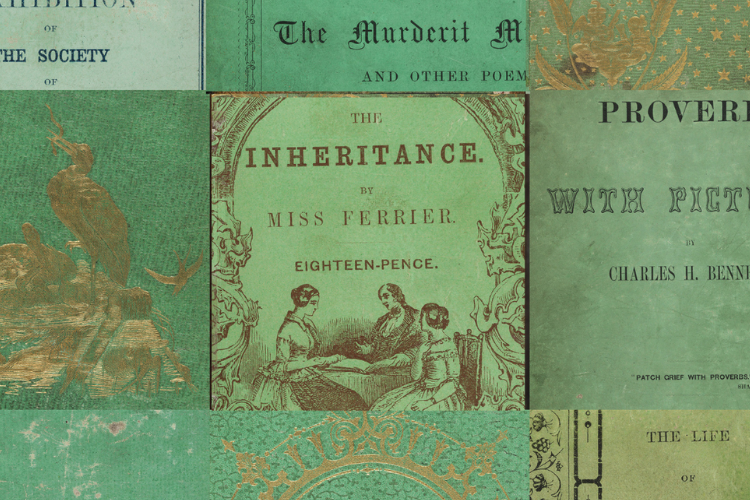An exhibition looking at hazardous substances found in historic bindings is currently on display at the Research Studio in the Wardlaw Museum. This blog highlights the exhibition and the current research into tools for the identification of poisonous books being undertaken by Libraries and Museums with the Schools of Environmental and Earth Sciences and Physics and Astronomy.

Pigments used to colour historic books often contain hazardous substances, posing significant handling risks. Notably, arsenic combined with copper forms a bright green pigment known as emerald green, prevalent in 19th-century books. This vivid green was widely popular and used in various everyday items, including clothing, artificial flowers, wallpapers, paints, sweet wrappers, and even cake decorations.

Arsenical Pigments
Arsenic, a naturally occurring element, was known for its toxicity in the 19th century. Despite its use as a rat poison, arsenic was also incorporated into everyday items, including clothing, food, and household objects.
The emerald green pigment, containing arsenic, caused severe health issues such as skin ulcers, vomiting, hair loss, and even death.
Museums and libraries worldwide have inherited these items from the past but with more of an understanding of their dangers. However, visual identification of which books are safe or harmful is not possible, as evidenced by the books displayed in the exhibition.

Identifying Emerald Green – The Visible Spectrum
A spectrum, or rainbow, is created when white light passes through a material like a prism, separating it into its component colours: red, orange, yellow, green, blue, indigo, and violet. These colours appear in a specific order based on their energy levels, with red having the lowest and violet the highest.

Light interacts with matter through reflection, refraction, and scattering. Scientists analyse the intensity of light in each colour to understand material properties. Historic pigments and dyes leave unique “fingerprints” on reflected light. Emerald green, a compound of arsenic and copper, has a very distinct light stamp that can be used to positively identify which books are poisonous.

Libraries & Museums heritage scientist, Dr Pilar Gil, used techniques which fall under the umbrella term of spectroscopy to discover emerald green’s unique fingerprint pattern. Although spectroscopy is very specialized and costly, emerald green’s unique light stamp is being applied to an inexpensive handheld tool being developed in the University of St Andrews, in a collaboration of Libraries and Museums with the Schools of Environmental and Earth Sciences and Physics and Astronomy. This tool will enable everyone to test their old green books for poisonous emerald green.

What do we do with emerald green books?
Emerald green books are dangerous because the pigment flakes off making it easy to absorb, breathe in or ingest small pieces of arsenic when using the book.
Arsenic on emerald green bindings in University Collections is contained by storing them in Ziplock polythene bags.
When the books are used, we check first if there are any other copies available which are not bound in emerald green. If not, the book is handled with special precautions such as the use of nitrile gloves.
What’s in the current exhibition at the Research Studio in the Wardlaw Museum?
When you visit the exhibition, you will find:
- A video explaining the project and the research behind it.
- Large panels showcasing the everyday uses of emerald green in the 19th century and some of the science behind optics and emerald green.
- Books on display, some containing emerald green and others requiring you to guess if they do.
- Various activities, including wearing green glasses to reveal the letters of a secret word hidden on the first floor of the gallery.

Discover more from University Collections blog
Subscribe to get the latest posts sent to your email.


Wow, I’m genuinely surprised by the outcome of this research on poisonous books! I never expected that something as seemingly harmless as old books could contain such dangerous substances. The fact that arsenic was used in the emerald green pigment for book bindings is truly shocking.
Thank for this blog post, the exhibition looks wonderful. Will this tool be available for other institutions to purchase?
Thanks for your comment, Andrew.
The current phase of the green books project will see the tool tested in several collecting institutions within the central belt of Scotland with a view to rolling it out further after that.
For more information on the project please contact [email protected]
There was a question about this on University Challenge on Monday night!
How long will the exhibition be on for? I shall be in St Andrews in mid-July and would love to see it.
Thanks for your comment Helen,
The exhibition is currently on until the 23rd of March, but please check out the following link to the Wardlaw Research Studio to see what’s on display while you’re in St Andrews.
https://researchstudio.wp.st-andrews.ac.uk/2024-poisonous-books-dangers-from-the-past/
Hi, I came here from an article in the Guardian dated 6th of June that claimed this exhibition is running until the end of July. I’m so disappointed to discover that it ended a couple of months ago. Perhaps you should reach out to the Guardian to request a correction to avoid others being disappointed too. So sorry I missed this exhibition.
Hi Naomi, thanks for your comment. Due to the popularity of the exhibition it was extended and will be available at the Wardlaw Museum until the 31st of July.
Hi Sarah, oh that is good news! I was so disappointed to have missed it. Lesson learned though, I’ve since subscribed to the blog. I’ll never miss another fascinating exhibition ever again and I am so relieved that I haven’t missed this one after all.
When did the use of this poisonous green pigment in book manufacture cease? I am wondering what would be a reasonable cut off date. We might have some poisonous old books in our homes!
Thanks for your comment.
For a book to contain arsenical green, it must have been bound between 1780 and the end of the 19th century.
Fascinating. It would be interesting to extend the analysis from books to stereocards and photographic mounts. There has been some interesting research recently on their composition which is not dissimilar to books. See: https://britishphotohistory.ning.com/xn/detail/28612104:BlogEntry:83926 and an event coming up on the subject shortly: https://britishphotohistory.ning.com/xn/detail/28612104:BlogEntry:85903
Many thanks for passing these links on! We are also very interested in stereocards and photographic mounts, and we are looking forward to the online event on 20 June.
I have green 19th C books in my personal collection including a couple of books in the same series as one illustrated above. Is there a way to get them tested? If not, what precautions should I take?
Hello Duncan,
Although emerald green bindings are unlikely to be found in private homes and collections, it is a fair question to ask. Here are some considerations and guidance:
• For a book to contain arsenical green, it must have been bound between 1780 and the end of the 19th century.
• It is good practice to wash your hands before and after handling old books or any other old items. Washing your hands afterwards will remove residues transferred from the object.
• Don’t eat or drink while handling old books.
• Store the book away from any direct heat and humidity sources, out of direct sunlight and out of reach of children.
• Place the book in a zip-lock bag or a suitable box of an appropriate size. This will contain any particles that might come off the book.
Note. Never place a damp or wet book in a bag as this will encourage mould growth!
• If you are concerned, please contact us with a photo of your book at [email protected]
When did publishers stop using this pigment on books?
Thanks for your question, Randall.
For a book to contain arsenical green, it must have been bound between 1780 and the end of the 19th century.